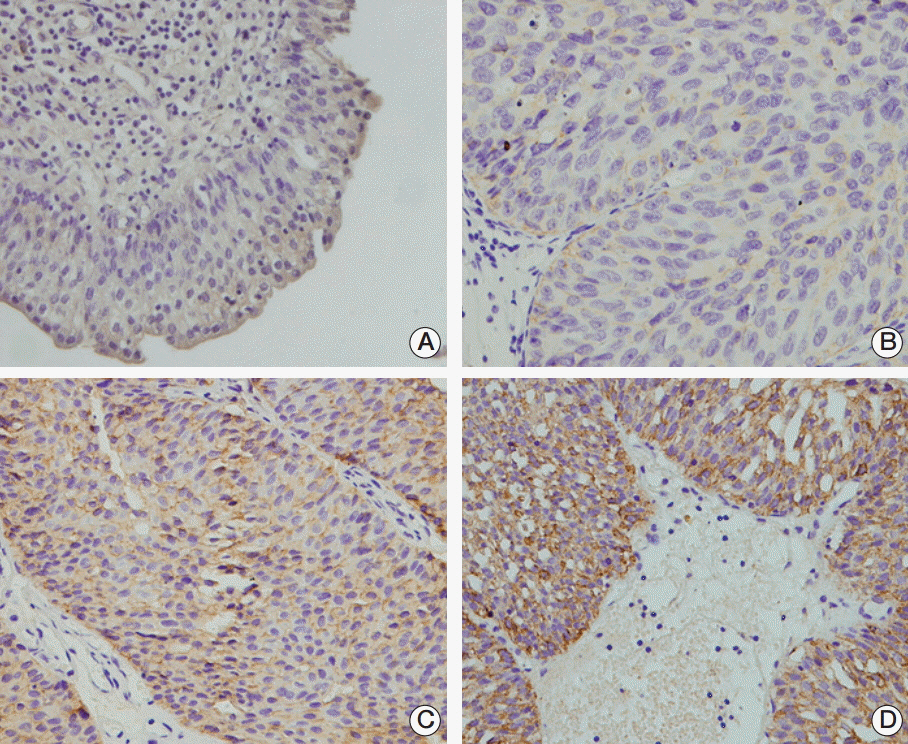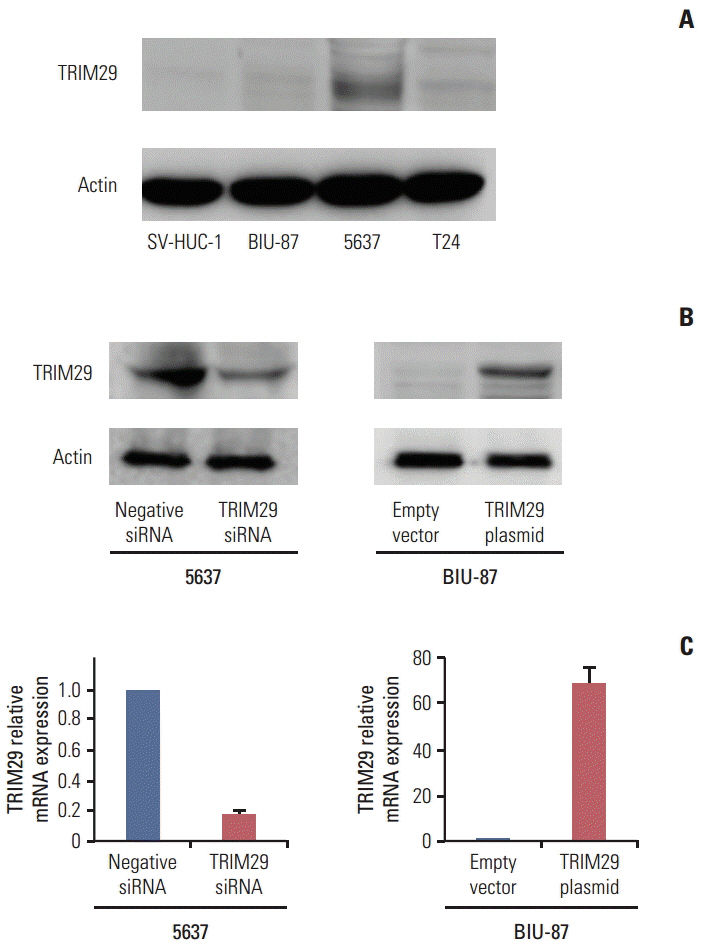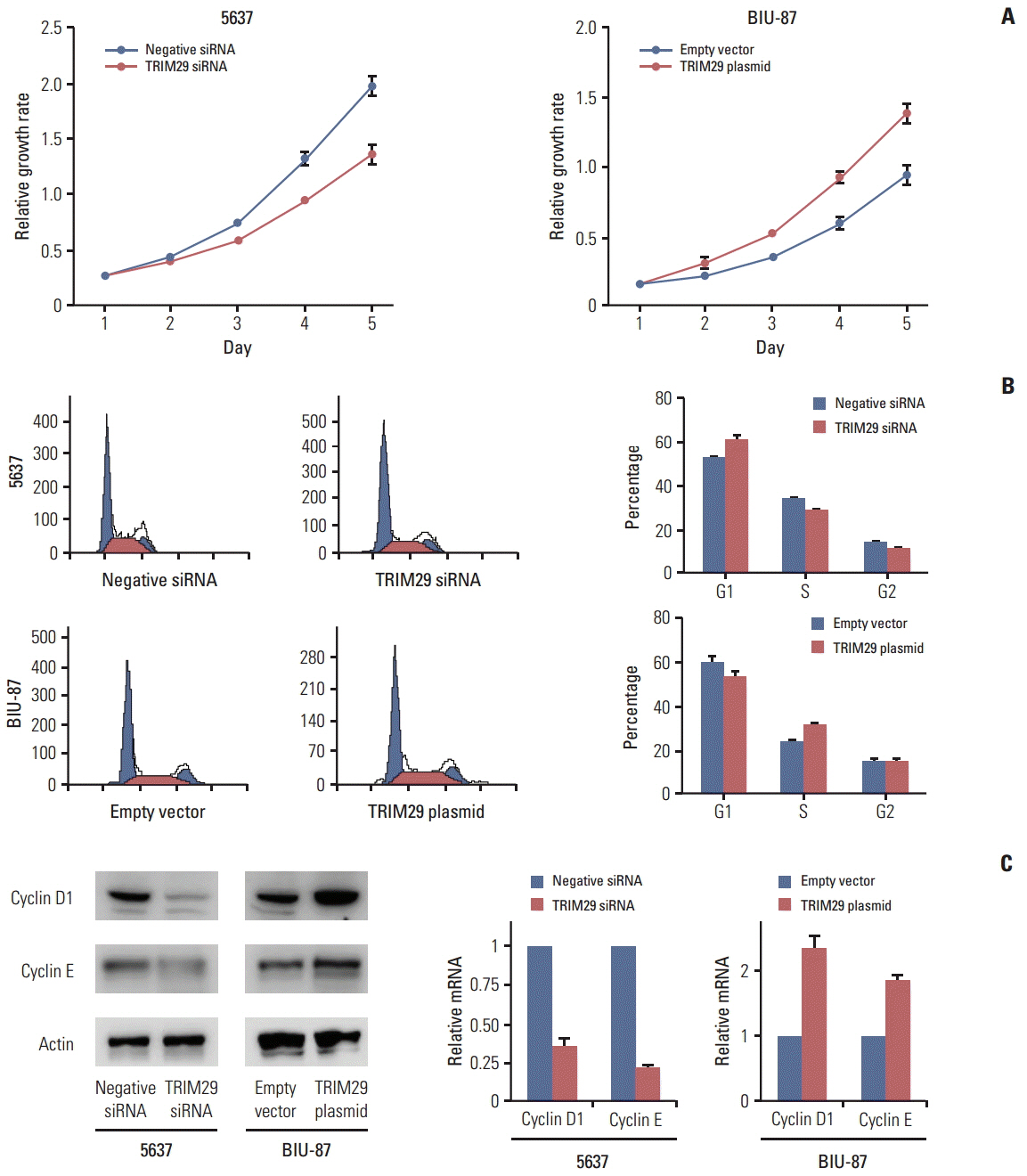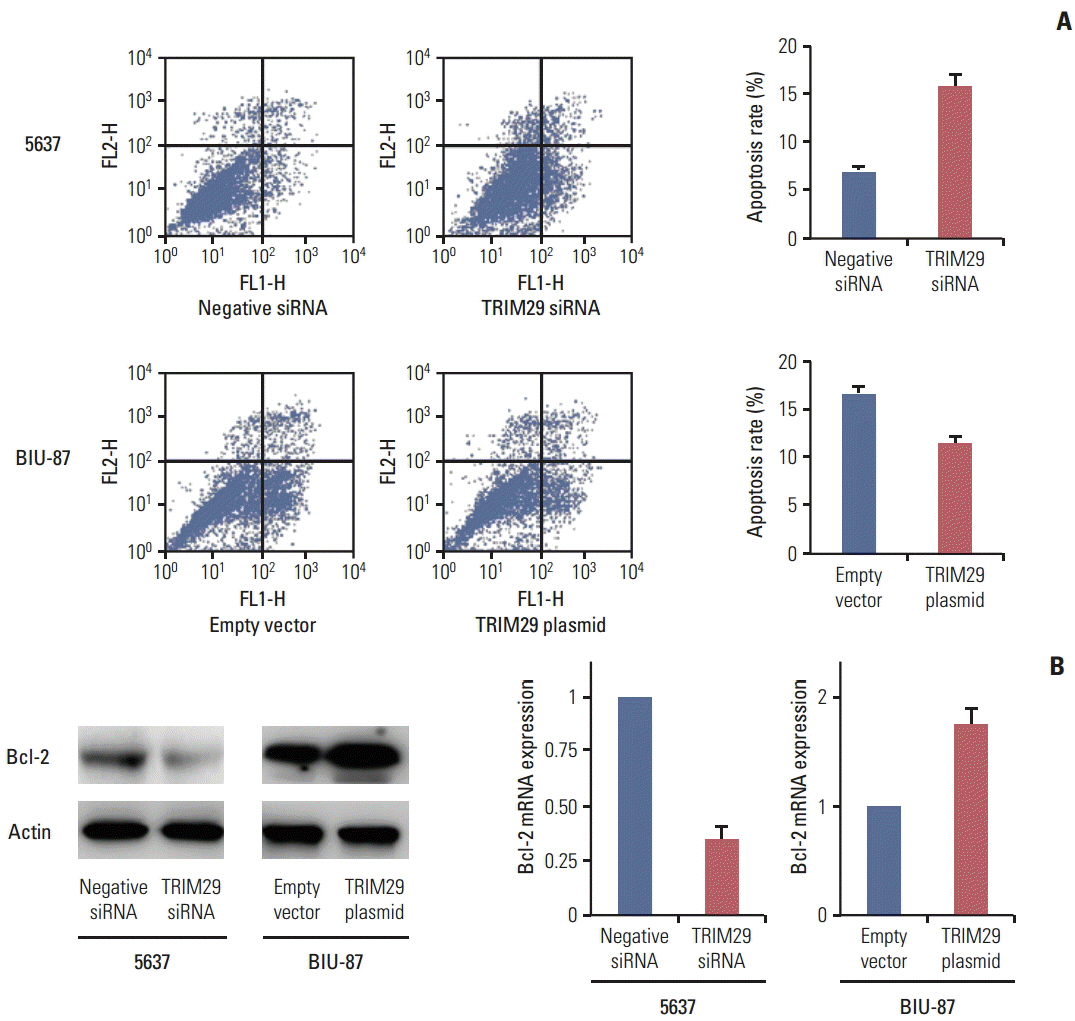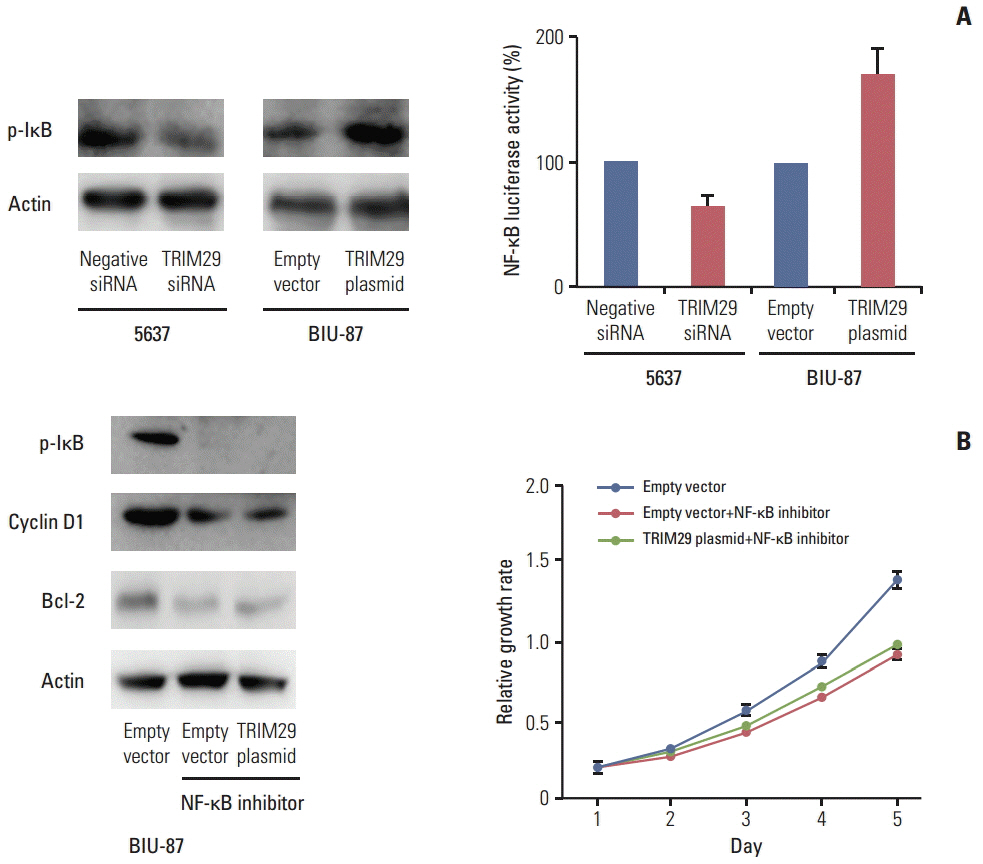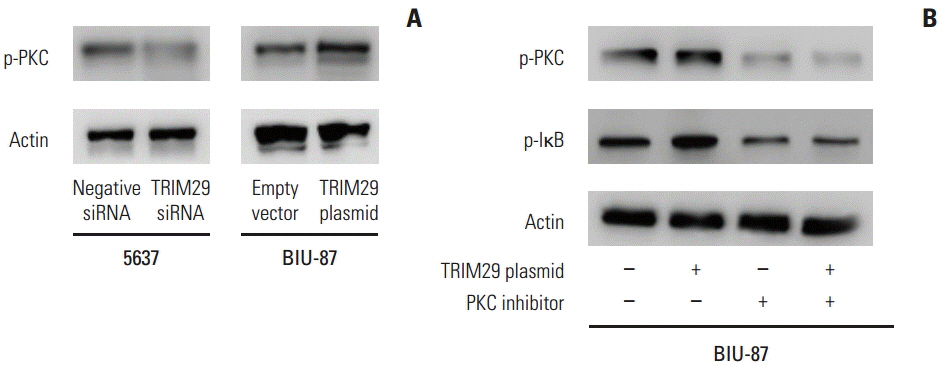Cancer Res Treat.
2016 Oct;48(4):1302-1312. 10.4143/crt.2015.381.
TRIM29 Overexpression Promotes Proliferation and Survival of Bladder Cancer Cells through NF-κB Signaling
- Affiliations
-
- 1Department of Urology, Shengjing Hospital of China Medical University, Shenyang, China. wubin_cmu@126.com
- KMID: 2356232
- DOI: http://doi.org/10.4143/crt.2015.381
Abstract
- PURPOSE
TRIM29 overexpression has been reported in several human malignancies and showed correlation with cancer cell malignancy. The aim of the current study is to examine its clinical significance and biological roles in human bladder cancer tissues and cell lines.
MATERIALS AND METHODS
A total of 102 cases of bladder cancer tissues were examined for TRIM29 expression by immunohistochemistry. siRNA and plasmid transfection were performed in 5637 and BIU-87 cell lines. Cell Counting Kit-8, flow cytometry, western blot, and real-time polymerase chain reaction were performed to examine its biological roles and mechanism in bladder cancer cells.
RESULTS
We found that TRIM29 overexpression showed correlation with invading depth (p=0.0087). Knockdown of TRIM29 expression in bladder cancer cell line 5637 inhibited cell growth rate and cell cycle transition while its overexpression in BIU-87 cells accelerated cell proliferation and cell cycle progression. TRIM29 overexpression also inhibited cell apoptosis induced by cisplatin. In addition, we demonstrated that TRIM29 depletion decreased while its overexpression led to upregulated expression of cyclin D1, cyclin E, and Bcl-2. We also showed that TRIM29 knockdown inhibited protein kinase C (PKC) and nuclear factor κB (NF-κB) signaling while its overexpression stimulated the PKC and NF-κB pathways. BAY 11-7082 (NF-κB inhibitor) partly attenuated the effect of TRIM29 on expression of cyclin and Bcl-2. Treatment with PKC inhibitor staurosporine resulted in ameliorated TRIM29 induced activation of NF-κB.
CONCLUSION
The current study demonstrated that TRIM29 upregulates cyclin and Bcl family proteins level to facilitate malignant cell growth and inhibit drug-induced apoptosis in bladder cancer, possibly through PKC-NF-κB signaling pathways.
Keyword
MeSH Terms
-
Apoptosis
Bays
Blotting, Western
Cell Count
Cell Cycle
Cell Line
Cell Proliferation
Cisplatin
Cyclin D1
Cyclin E
Cyclins
Flow Cytometry
Humans
Immunohistochemistry
Plasmids
Protein Kinase C
Real-Time Polymerase Chain Reaction
RNA, Small Interfering
Staurosporine
Transfection
Urinary Bladder Neoplasms*
Urinary Bladder*
Cisplatin
Cyclin D1
Cyclin E
Cyclins
Protein Kinase C
RNA, Small Interfering
Staurosporine
Figure
Reference
-
References
1. Siegel R, Naishadham D, Jemal A. Cancer statistics, 2012. CA Cancer J Clin. 2012; 62:10–29.
Article2. Kosaka Y, Inoue H, Ohmachi T, Yokoe T, Matsumoto T, Mimori K, et al. Tripartite motif-containing 29 (TRIM29) is a novel marker for lymph node metastasis in gastric cancer. Ann Surg Oncol. 2007; 14:2543–9.
Article3. Li Q, Yan J, Mao AP, Li C, Ran Y, Shu HB, et al. Tripartite motif 8 (TRIM8) modulates TNFalpha- and IL-1beta-triggered NF-kappaB activation by targeting TAK1 for K63-linked polyubiquitination. Proc Natl Acad Sci U S A. 2011; 108:19341–6.4. Noguchi K, Okumura F, Takahashi N, Kataoka A, Kamiyama T, Todo S, et al. TRIM40 promotes neddylation of IKKgamma and is downregulated in gastrointestinal cancers. Carcinogenesis. 2011; 32:995–1004.5. Tang ZP, Dong QZ, Cui QZ, Papavassiliou P, Wang ED, Wang EH. Ataxia-telangiectasia group D complementing gene (ATDC) promotes lung cancer cell proliferation by activating NF-kappaB pathway. PLoS One. 2013; 8:e63676.6. Kanno Y, Watanabe M, Kimura T, Nonomura K, Tanaka S, Hatakeyama S. TRIM29 as a novel prostate basal cell marker for diagnosis of prostate cancer. Acta Histochem. 2014; 116:708–12.
Article7. Liu J, Welm B, Boucher KM, Ebbert MT, Bernard PS. TRIM29 functions as a tumor suppressor in nontumorigenic breast cells and invasive ER+ breast cancer. Am J Pathol. 2012; 180:839–47.
Article8. Jiang T, Tang HM, Lu S, Yan DW, Yang YX, Peng ZH. Up-regulation of tripartite motif-containing 29 promotes cancer cell proliferation and predicts poor survival in colorectal cancer. Med Oncol. 2013; 30:715.
Article9. Seo M, Nam HJ, Kim SY, Juhnn YS. Inhibitory heterotrimeric GTP-binding proteins inhibit hydrogen peroxide-induced apoptosis by up-regulation of Bcl-2 via NF-kappaB in H1299 human lung cancer cells. Biochem Biophys Res Commun. 2009; 381:153–8.10. Knudsen KE, Diehl JA, Haiman CA, Knudsen ES. Cyclin D1: polymorphism, aberrant splicing and cancer risk. Oncogene. 2006; 25:1620–8.
Article11. Juan G, Cordon-Cardo C. Intranuclear compartmentalization of cyclin E during the cell cycle: disruption of the nucleoplasm-nucleolar shuttling of cyclin E in bladder cancer. Cancer Res. 2001; 61:1220–6.12. Cho HJ, Kim JK, Kim KD, Yoon HK, Cho MY, Park YP, et al. Upregulation of Bcl-2 is associated with cisplatin-resistance via inhibition of Bax translocation in human bladder cancer cells. Cancer Lett. 2006; 237:56–66.
Article13. Schaaf A, Sagi S, Langbein S, Trojan L, Alken P, Michel MS. Cytotoxicity of cisplatin in bladder cancer is significantly enhanced by application of bcl-2 antisense oligonucleotides. Urol Oncol. 2004; 22:188–92.
Article14. Lee SJ, Lim JH, Choi YH, Kim WJ, Moon SK. Interleukin-28A triggers wound healing migration of bladder cancer cells via NF-kappaB-mediated MMP-9 expression inducing the MAPK pathway. Cell Signal. 2012; 24:1734–42.15. Kim JK, Kim KD, Lee E, Lim JS, Cho HJ, Yoon HK, et al. Up-regulation of Bfl-1/A1 via NF-kappaB activation in cisplatin-resistant human bladder cancer cell line. Cancer Lett. 2004; 212:61–70.16. Miao Z, Zhao T, Wang Z, Xu Y, Song Y, Wu J, et al. CARMA3 is overexpressed in colon cancer and regulates NF-kappaB activity and cyclin D1 expression. Biochem Biophys Res Commun. 2012; 425:781–7.17. El-Kady A, Sun Y, Li YX, Liao DJ. Cyclin D1 inhibits whereas c-Myc enhances the cytotoxicity of cisplatin in mouse pancreatic cancer cells via regulation of several members of the NF-kappaB and Bcl-2 families. J Carcinog. 2011; 10:24.18. Wang X, Wang Q, Hu W, Evers BM. Regulation of phorbol ester-mediated TRAF1 induction in human colon cancer cells through a PKC/RAF/ERK/NF-kappaB-dependent pathway. Oncogene. 2004; 23:1885–95.19. Shi MD, Shih YW, Lee YS, Cheng YF, Tsai LY. Suppression of 12-O-tetradecanoylphorbol-13-acetate-induced MCF-7 breast adenocarcinoma cells invasion/migration by alpha-tomatine through activating PKCalpha/ERK/NF-kappaB-dependent MMP-2/MMP-9 expressions. Cell Biochem Biophys. 2013; 66:161–74.
- Full Text Links
- Actions
-
Cited
- CITED
-
- Close
- Share
- Similar articles
-
- Controls of Nuclear Factor-Kappa B Signaling Activity by 5’-AMP-Activated Protein Kinase Activation With Examples in Human Bladder Cancer Cells
- PLCE1 Promotes the Invasion and Migration of Esophageal Cancer Cells by Up-Regulating the PKCα/NF-κB Pathway
- NF-κB signaling regulates cell-autonomous regulation of CXCL10 in breast cancer 4T1 cells
- LETM1 Promotes Gastric Cancer Cell Proliferation, Migration, and Invasion via the PI3K/Akt Signaling Pathway
- IKKγ Facilitates the Activation of NF-κB by Hepatitis C Virus Core Protein

